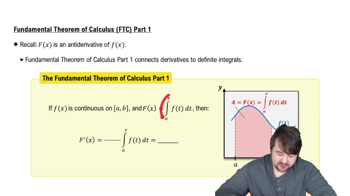Suppose w(t) is the weight (in pounds) of a golden retriever puppy t weeks after it is born. Interpret the meaning of w'(15) = 1.75.
Table of contents
- 0. Functions7h 54m
- Introduction to Functions16m
- Piecewise Functions10m
- Properties of Functions9m
- Common Functions1h 8m
- Transformations5m
- Combining Functions27m
- Exponent rules32m
- Exponential Functions28m
- Logarithmic Functions24m
- Properties of Logarithms36m
- Exponential & Logarithmic Equations35m
- Introduction to Trigonometric Functions38m
- Graphs of Trigonometric Functions44m
- Trigonometric Identities47m
- Inverse Trigonometric Functions48m
- 1. Limits and Continuity2h 2m
- 2. Intro to Derivatives1h 33m
- 3. Techniques of Differentiation3h 18m
- 4. Applications of Derivatives2h 38m
- 5. Graphical Applications of Derivatives6h 2m
- 6. Derivatives of Inverse, Exponential, & Logarithmic Functions2h 37m
- 7. Antiderivatives & Indefinite Integrals1h 26m
- 8. Definite Integrals4h 44m
- 9. Graphical Applications of Integrals2h 27m
- 10. Physics Applications of Integrals 3h 16m
- 11. Integrals of Inverse, Exponential, & Logarithmic Functions2h 31m
- 12. Techniques of Integration7h 41m
- 13. Intro to Differential Equations2h 55m
- 14. Sequences & Series5h 36m
- 15. Power Series2h 19m
- 16. Parametric Equations & Polar Coordinates7h 58m
4. Applications of Derivatives
Related Rates
Problem 4.2.1
Textbook Question
Explain Rolle’s Theorem with a sketch.
 Verified step by step guidance
Verified step by step guidance1
Rolle's Theorem is a fundamental result in calculus that applies to continuous functions. It states that if a function f is continuous on a closed interval [a, b], differentiable on the open interval (a, b), and f(a) = f(b), then there exists at least one c in (a, b) such that the derivative f'(c) = 0.
To visualize Rolle's Theorem, imagine a smooth curve representing the function f(x) on the interval [a, b]. Since f(a) = f(b), the curve starts and ends at the same height, creating a horizontal line at these endpoints.
The requirement that the function is continuous and differentiable ensures that there are no breaks, jumps, or sharp corners in the curve. This smoothness implies that somewhere between a and b, the curve must have a horizontal tangent line, indicating a point where the slope is zero.
Sketch the graph of a function that satisfies the conditions of Rolle's Theorem. Start by drawing the x-axis and marking the points a and b. Plot the function such that f(a) = f(b), ensuring the curve is smooth and continuous between these points.
Identify the point c in the interval (a, b) where the tangent to the curve is horizontal. This point c is where the derivative f'(c) = 0, demonstrating the conclusion of Rolle's Theorem.
 Verified video answer for a similar problem:
Verified video answer for a similar problem:This video solution was recommended by our tutors as helpful for the problem above
Video duration:
6mPlay a video:
Was this helpful?
Key Concepts
Here are the essential concepts you must grasp in order to answer the question correctly.
Rolle's Theorem
Rolle's Theorem states that if a function is continuous on a closed interval [a, b], differentiable on the open interval (a, b), and the function values at the endpoints are equal (f(a) = f(b)), then there exists at least one point c in (a, b) where the derivative f'(c) = 0. This theorem is fundamental in understanding the behavior of functions and their critical points.
Recommended video:

Fundamental Theorem of Calculus Part 1
Continuity and Differentiability
Continuity of a function at a point means that the function does not have any breaks, jumps, or holes at that point, while differentiability means that the function has a defined derivative at that point. For Rolle's Theorem to apply, the function must be both continuous on the closed interval and differentiable on the open interval, ensuring smooth behavior without abrupt changes.
Recommended video:

Intro to Continuity
Critical Points
Critical points of a function occur where its derivative is zero or undefined. In the context of Rolle's Theorem, the existence of at least one critical point c, where f'(c) = 0, indicates that the function has a horizontal tangent line at that point. This is significant for analyzing the function's local maxima and minima within the interval.
Recommended video:

Critical Points

 4:16m
4:16mWatch next
Master Intro To Related Rates with a bite sized video explanation from Patrick
Start learningRelated Videos
Related Practice
Textbook Question
